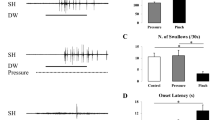Abstract
To elucidate the role of the water receptor in the frog (Rana catesbeiana), reflex activities elicited by its excitation were studied. Application of tap water to the oral mucosa depressed the rhythmical movement of gorge (buccal) respiration, accompanied by an elevation of the inner pressure of the oral cavity (buccal pressure). Tonic reflex discharges were elicited in the nerves innervating the submental and submaxillary muscles, which close the nostrils, the pterygoid and the profound portion of the major masseter muscles, which produce a strong bite, and the geniohyoid and hyoglossus muscles, which elevate buccal pressure. These muscles, except for the pterygoid, also participate in the rhythmical movement of gorge respiration as expiratory muscles. Rhythmical movements in the minor masseter and sternohyoid muscles, which act as inspiratory muscles in gorge respiration, were depressed by the water stimulation of the oral mucosa. These findings indicate that the water receptor plays a role in the interruption of gorge respiratory movements, accompanied by an elevation of buccal pressure.
Similar content being viewed by others
References
Casella C, Rapuzzi G (1957) Azione dell' acqua, del CaCl2 e del NaCl sui ricettori linguali nella Rana. Arch Sci Biol 41:191–203
Ito F, Watanabe S (1962) Localization and organization of respiratory neurons in the brain-stem of the toad, with reference to activities of slow motor system. Jpn J Physiol 12:611–622
Jongh HJ De, Gans C (1969) On the mechanism of respiration in the bullfrog, Rana catesbeiana: A reassessment. J Morphol 122:259–290
Koketsu K (1951) Impulses from receptors in the tongue of a frog. Kyushu Mem Med Sci 2:53–65
Kuffler SW, Laporte Y, Ransmeier RE (1947) The function of the frog's small-nerve motor system. J Neurophysiol 10:395–408
Nomura H, Kumai T (1981) Reflex discharge evoked by water stimulation on the frog tongue. Brain Res 221:198–201
Nomura H, Kumai T (1984) Jaw-closing reflex elicited by water stimulation of oral mucosa in the frog. Jpn J Oral Biol 26:259–261
Nomura H, Sakada S (1965) On the “water response” of frog's tongue. Jpn J Physiol 15:433–443
Sakakibara Y (1984) The pattern of respiratory nerve activity in the bullfrog. Jpn J Physiol 34:269–282
Shinkai K, Narita T (1956) Electromyographical studies on toads respiratory movements. Nagoya J Med Sci 19:1–6
Suzuki H (1989) Motor control of a tonic jaw reflex in the frog. J Matsumoto Dental Coll Soc 15:150–166 (in Japanese)
West NH, Jones DR (1975) Breathing movements in the frog Rana pipiens. I. The mechanical events associated with lung and buccal ventilation. Can J Zool 53:332–344
Zotterman Y (1949) The response of the frog's taste fibers to the application of pure water. Acta Physiol Scand 18:181–189
Author information
Authors and Affiliations
Rights and permissions
About this article
Cite this article
Nomura, H., Suzuki, H. Role of water receptor in the frog. J Comp Physiol A 176, 11–15 (1995). https://doi.org/10.1007/BF00197748
Accepted:
Issue Date:
DOI: https://doi.org/10.1007/BF00197748




